Qibao Ancient Town (七宝古镇) is a historic water town located in the southwest of Shanghai, China. It has a history that dates back over a thousand years and is known for its charming waterways, traditional architecture, and rich cultural heritage. Qibao means “seven treasures,” and the town is named after the seven treasures of Buddhism.
The town’s most distinctive feature is its well-preserved canal system, which includes nine bridges and many waterways that flow throughout the town. Visitors can take a boat ride to admire the scenic views or stroll along the old streets lined with ancient buildings that have been restored to their former glory.
Qibao Ancient Town is also famous for its food and handicrafts. Local specialties include glutinous rice dumplings, sugar-coated haws, and sesame cakes. Visitors can also watch traditional craftsmen making intricate paper-cutting, embroidery, and woodcarving products.
Table of Contents
- Basic Information
- Location and Transportation
- Highlights of Qibao Ancient Town
- Map and Recommended Route
- Vlog About Qibao Ancient Town
- Popular Snacks in Qibao Ancient Town
- History of Qibao Ancient Town
- Useful Tips Summarized from Reviews
- Other Ancient Towns in Shanghai
Basic Information
| Website | https://www.shqbgz.com/ |
| Estimated Length of Tour | Over 3 Hours |
| Ticket Price | Free, but there is a small charge for the temple and museum |
| Opening Hours | 24 hours, but most street stalls and vendors operate from 9.00 to 21.00 |
| Telephone Number | 0086-021-64610016 0086-021-64615308 |
Location and Transportation
Qibao Ancient Town is located in the Minhang District of Shanghai, China, approximately 18 kilometers southwest of the city center. It is situated along Qibao Creek, which is a tributary of the Huangpu River. The town is easily accessible by public transportation, including a metro line and various bus routes.
Bus: Take bus 87, 91, 92, 186, 189, 196, 198, 709, 735, or 803, get off at Qibao Stop (七宝站), and walk about 400 meters to the south to reach the ancient town.
Metro: Take metro line 9, get off at Qibao Station, get out from Exit 2, and walk about 300 meters to the south to reach the ancient town.
Highlights of Qibao Ancient Town
Qibao Old Street
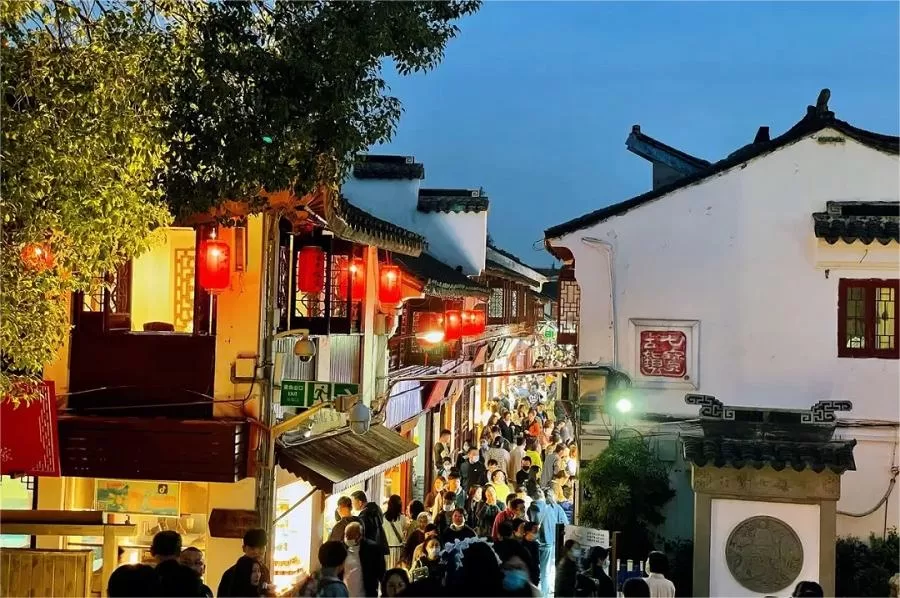
Qibao Old Street is a charming pedestrian street in Qibao Ancient Town, Shanghai. It is lined with traditional buildings that date back to the Ming and Qing Dynasties, and is a great place to experience the town’s history and culture. Visitors can stroll along the street and explore the many shops, food stalls, and handicraft workshops, offering a variety of goods and souvenirs. The street is also home to several historic buildings, including the Qibao Temple and the Qing Dynasty Post Office.
Pu Huai Tang Bridge
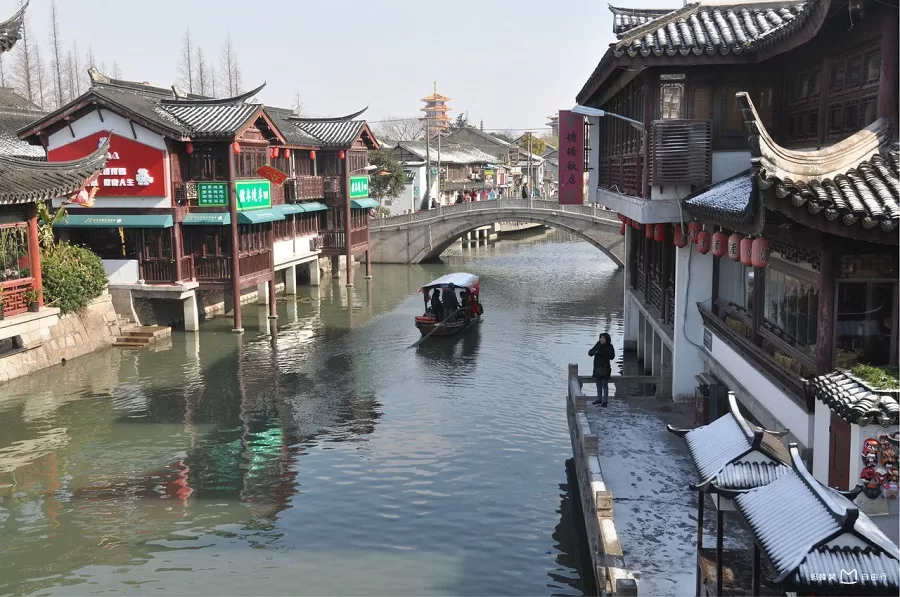
Built in 1518 during the Ming Dynasty’s Zhengde period, Pu Huai Tang Bridge is over 500 years old. It was planned and funded by Xu Shou and Zhang Xun from Qibao North Town. The bridge’s completion marked the center of Qibao Ancient Town’s unique layout. Arranged in a “non”-shaped pattern with the bridge at its core, the town features a north-south main street and a series of east-west alleys. This layout contributed to Qibao’s distinct character, setting it apart from other Jiangnan water towns. The town is described in the Wanli edition of the “Qingpu County Chronicle” as a bustling hub with a dense population, thriving commerce, and prominent scholars, making it a significant urban center.
Ancient Temples
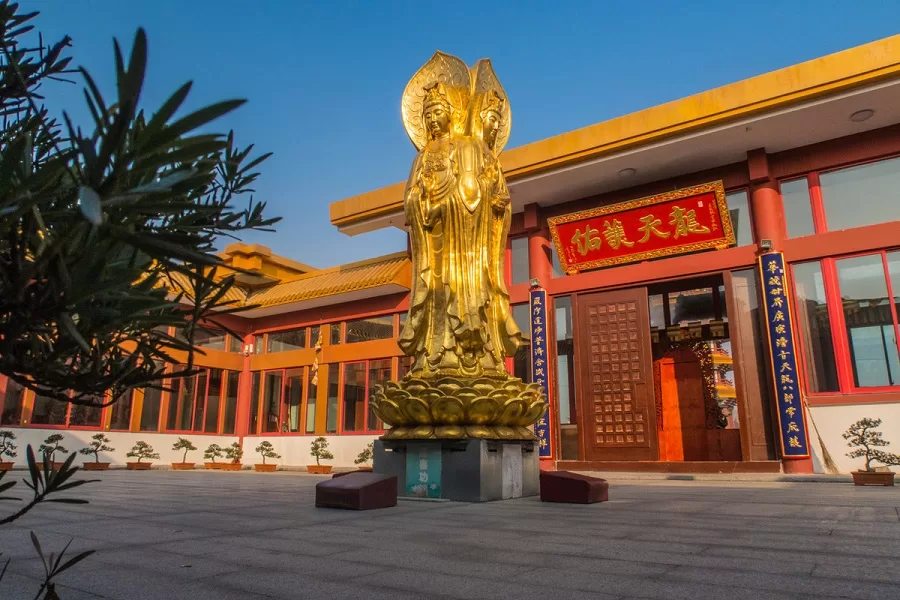
Originally known as Lu Bao Yuan, Qibao Temple was established during the Tianfu era of the Later Jin Dynasty in the Five Dynasties and Ten Kingdoms period. It was originally a family shrine for Lu Ji and Lu Yun, descendants of the Eastern Wu general Lu Xun from the Three Kingdoms period. During the Five Dynasties and Ten Kingdoms period, the King of Wuyue, Qian Liu, renamed it Qibao Temple. In 1008, the Northern Song Emperor Zhao Heng granted the temple the name “Qibao Temple,” marking its transition from a family shrine to an authentic Buddhist monastery. Since then, the temple has flourished, with increasing devotion and prominence.
Located at the Shanghai Jiao Tong University College of Agriculture and Biology, Dongyue Xingci Doumu Pavilion is a representative historical building of Qibao Ancient Town. The exact construction date is unknown. In the first year of the Jiaqing era of the Qing Dynasty (1796–1820), the pavilion was converted into a stage for performances. It features a shrine to Doumu God in the front, while performances are held in the back for the City God.
Qibao Catholic Church
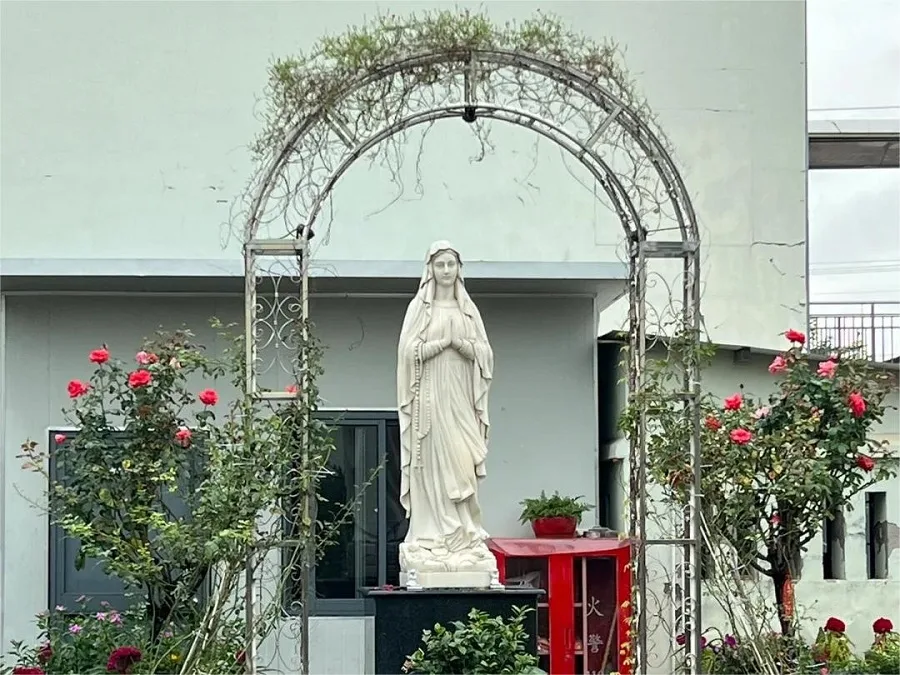
Established in the sixth year of the Tongzhi reign (1867) of the Qing Dynasty, Qibao Catholic Church is one of the oldest Catholic churches in the Shanghai region. It predates the well-known Xujiahui Catholic Church and the Sheshan Catholic Church. After the reform and opening-up period, a convent and a Bible printing factory were added beside the church. Together, the church, convent, and printing factory form a rare Catholic cultural enclave in the country
Various Museums
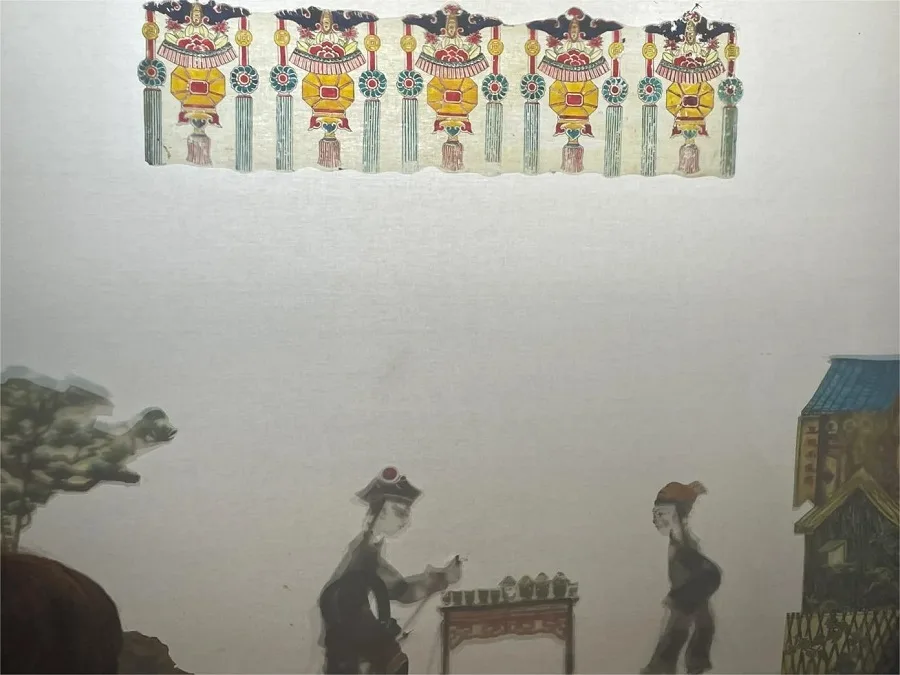
The Qibao Art Museum, also known as the Qibao Calligraphy Art Museum, houses some of the most representative and influential works of “Haipai” calligraphy since the founding of the People’s Republic of China. It also features calligraphy works by local authors from “China’s Calligraphy Town—Qibao.” The museum’s calligraphy section, stretching over 200 meters, displays most of the outstanding pieces from the “Shanghai Calligraphy Exhibition in Beijing.”
The Zhang Chongren Memorial Museum is dedicated to honoring Zhang Chongren and covers an area of 800 square meters, with a building area of 600 square meters. The museum includes four main exhibition areas: “Preface Hall,” “Famed in Europe,” “Studio Spring and Autumn,” and “Master of Sculpture.” It showcases Zhang Chongren’s sculptures, paintings, artifacts, and related photos and newspaper clippings.
The Qibao Shadow Puppet Art Museum is a comprehensive art museum that integrates the exhibition, production, performance, research, and collection of Qibao shadow puppetry. Known for its colorful painting, the Qibao shadow puppetry is characterized by its elegant and bright appearance, exaggerated and vivid shapes, and strong decorative effect.
Local Cuisine
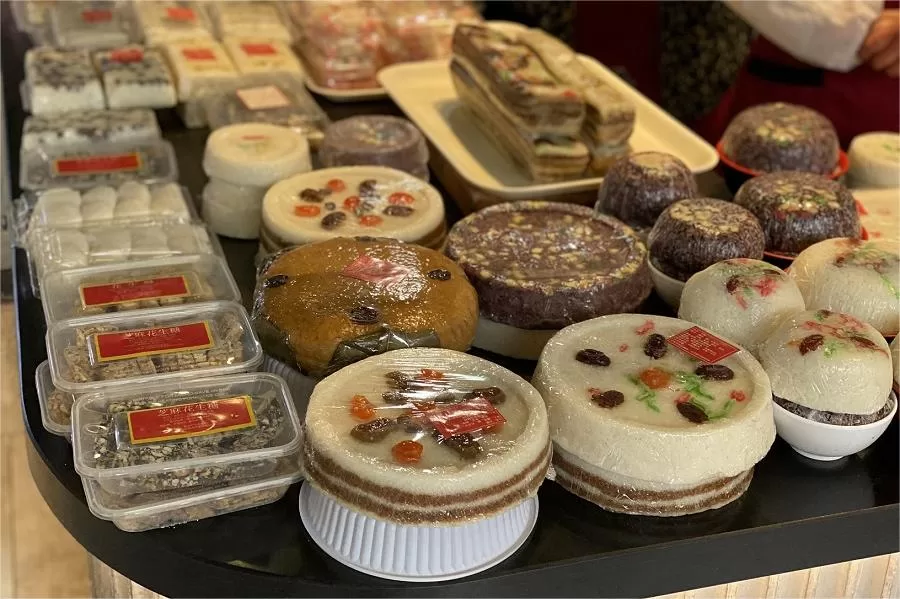
Qibao Marinated Pork
Qibao marinated pork has been a beloved local dish since the late Qing Dynasty and early Republic period. It is made from pork ribs, which are salted and marinated for 2 to 3 days, then air-dried. The pork is then mixed with glutinous rice and wine and sealed in a jar for about half a month. It is steamed before serving.
Fang Cake
A well-known story from the Song Dynasty tells of the famous scholar Fan Zhongyan, who grew up in poverty. His meals consisted of porridge, which he would freeze into blocks during cold winter nights. When he was hungry, he would eat a piece of the frozen porridge. His friend, Shi Haiqing, learned of this and began sending glutinous rice cakes made in the same way as Fan Zhongyan’s porridge, calling them “Bai Ruan Gao” (white soft cakes).
Map and Recommended Route
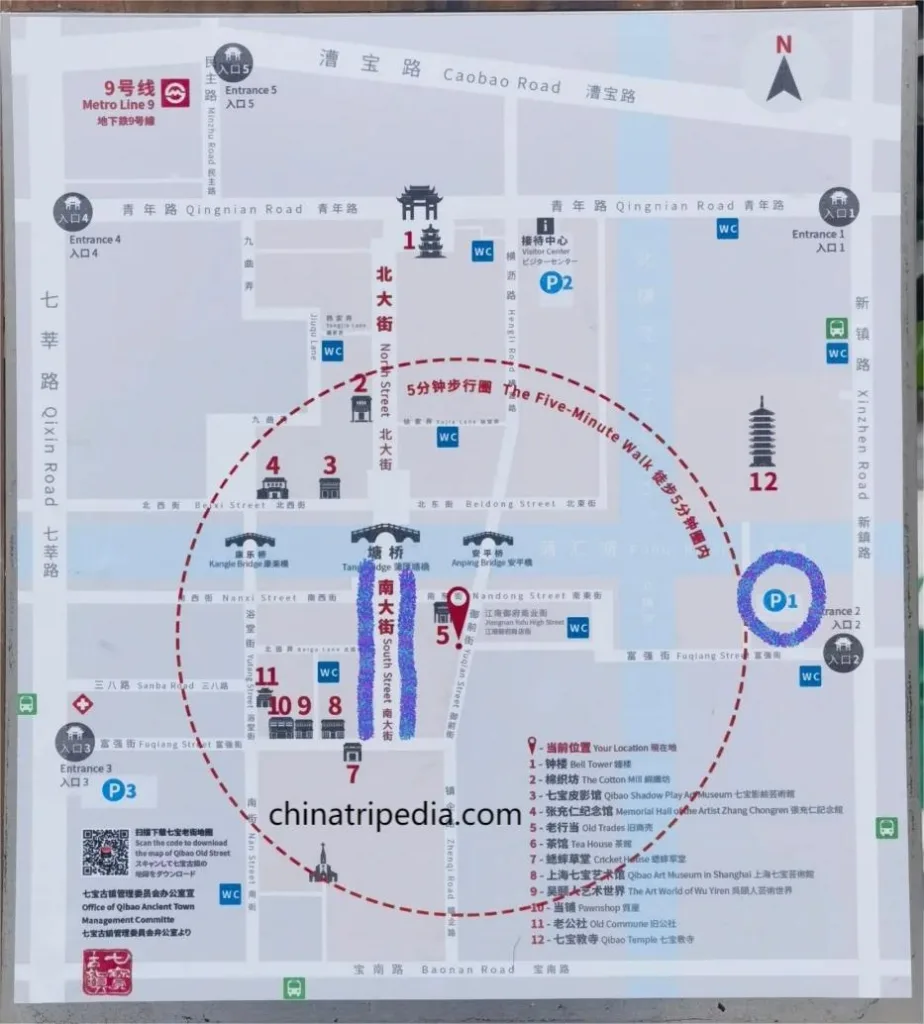
Recommended Route:
Qibao Ancient Town – Tourist Center – Bell Tower Square – Qibao Old Street Archway – Qibao Shadow Puppet Art Museum – Zhang Chongren Memorial Museum – Puxifang Archway – Shanghai Qibao Art Museum – Qibao Church – Cricket Grass Hall – Qibao Temple
Vlog About Qibao Ancient Town
Popular Snacks in Qibao Ancient Town
| Food Item | Description | Price |
|---|---|---|
| Dry Steamed Dumpling Shop (干蒸圆子店) | Locals queue for the white version with shepherd’s purse and fresh meat. The green version is said to be a type of Qing Tuan (sweet green dumpling). The shepherd’s purse has a subtle flavor. | ¥4 each |
| Lao Wu Scallion Pancake (老五葱油饼) | Despite the long line, service is quick. The pancake has a crispy exterior, hollow inside with scallions, and a mild taste. It’s less oily and not very fragrant. | ¥6 each |
| Qibao Old Street Tangyuan Shop (七宝老街汤圆店) | Try both sweet and savory. The sesame filling has a thick skin, while the fresh meat filling has a thinner skin but might not be to everyone’s taste. It’s not as sweet and delicious as those from Suzhou. | ¥5 each |
| Si Ru Chun (四如春) | A popular spot with long queues and average service. The skewers include: – Pork Tenderloin: ¥5 each, large and thick – Squid: ¥15 each, not very large, not well-cooked – Ham Sausage: ¥5 each, starchy and not crispy – Garlic Rice Cake: ¥3 each, average texture | ¥5-15 each |
| Spicy Crying Pancake (辣哭饼) | A mix of fresh meat, tofu, and green beans with mild spiciness. If it’s not spicy enough, extra chili can be added. Overall, it tastes good. | ¥16 per serving |
| Shunchang Renshou Stuffed Egg (顺昌仁寿灌蛋) | Stuffed duck eggs with a filling cooked in a seaweed, scallion, and cilantro broth. It combines the flavors of boiled eggs and steamed meat patties, offering a unique taste experience. | ¥16 per serving |
| Northwestern Steamed Cake (大西北甑糕) | Generous portions with fillings of red dates, honey dates, red beans, and glutinous rice. Available in large and medium sizes. The medium portion is sufficient for 2-3 people. It tastes like a finer version of red date sticky rice dumplings. Beware of broken date pits. | ¥15-20 per serving |
| Baofeng Pastry (宝丰糕点) | Not tried as the reviewer does not like Huatang Cake, but those who enjoy it might want to give it a try. | N/A |
| Yipin Square Cake (一品方糕) | For those used to glutinous rice cakes, the popular pumpkin-flavored square cake is priced at ¥30 each. | ¥30 each |
| Warm Dad Fresh Rice Wine (暖爸鲜爽米酒) | The reviewer did not try this but noted that free samples are available. Wine lovers may want to give it a try. | Free samples available |
History of Qibao Ancient Town
Qibao Ancient Town’s history dates back to the Eastern Han Dynasty, originally named after a local ancestral hall.
In 303 AD, during the Western Jin Dynasty, the literary figures Lu Ji and Lu Yun, who were falsely accused, were executed by Sima Ying. Their descendants established an ancestral hall in Songjiang, initially called Lu Bao Yuan, which was later renamed Lu Bao An. According to local historical records, this was the beginning of Qibao’s heritage.
During the Five Dynasties and Ten Kingdoms period, Lu Bao An was relocated to the banks of the Wu Song River (now Suzhou Creek). The King of Wu Yue, Qian Liu, mistakenly interpreted “Lu Bao” as “Liubao” and renamed the hall to “Qibao Temple” when bestowing the “Golden Lotus Scripture,” referring to it as another treasure.
In the early Northern Song Dynasty, due to erosion from the Wu Song River, Qibao Temple was moved again to the north of Pu Hui Tang (now Minhang District’s Qibao Town). In 1008 AD, during the reign of Emperor Zhenzong of the Song Dynasty, the temple was officially renamed “Qibao Teaching Temple,” and Qibao Town was formally established.
In 1518, during the Ming Dynasty, local wealthy merchants Xu Shou and Zhang Xun funded the construction of Pu Hui Tang Bridge.
During the Qing Dynasty’s Xianfeng period, Qibao Teaching Temple declined due to wars.
In the late 1980s to mid-1990s, as development expanded around Qibao Ancient Town, its area diminished to about 16 hectares, confined to the south of Youth Road, east of Bath Street, north of Fuqiang Street, and west of Hengli Road.
In 1998, there was a debate over whether to demolish or preserve Qibao Ancient Town amid economic development.
By 2000, Qibao Ancient Town was preserved, and the first phase of restoration began. The Qibao Teaching Temple was relocated and rebuilt, completing the project the following year. The Four-Sided Hall was also extensively repaired to maintain its original appearance.
By 2001, the restoration and renovation of Qibao Ancient Town were completed.
Useful Tips Summarized from Reviews
Enjoy the Scenery: The ancient town is not large, but it offers charming scenery, especially in spring. Take a leisurely stroll to experience the tranquility away from the hustle and bustle of the city.
Main Streets: The main thoroughfare consists of North and South Streets. North Street mainly features antique shops and jewelry stores, while South Street is known for its diverse food options.
Normal Souvenirs: Inside the old streets, you’ll find typical scenes found in most ancient towns, with shops selling goods sourced from Yiwu, a major wholesale market in China.
Seating Availability: Many food stalls may not have seating arrangements. As autumn approaches, it can get chilly, especially when standing outside to eat.
Unique Experience: One of the unique experiences of Qibao is the juxtaposition of ancient scenery with modern elements. While admiring the picturesque view of the Jiangnan-style bridges and waterways from the arched bridges, you may hear the roaring sound of airplanes passing overhead, creating a sense of time and space crossing between the past and present.


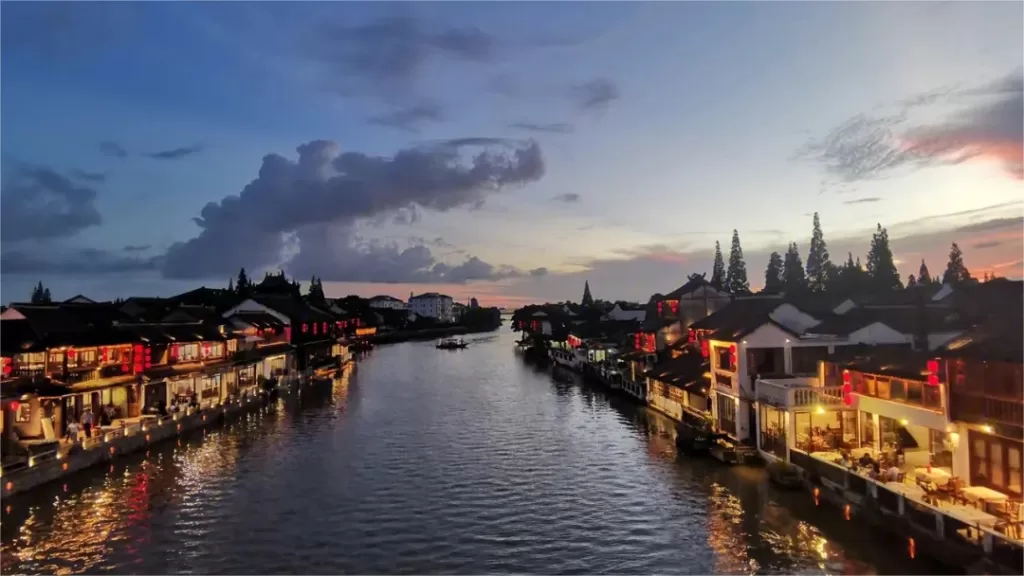



The Qibao Ancient Town feels like an ordinary commercial street and snack street. It seems that everything is becoming increasingly homogenized; the scenery here is quite similar to what I experienced at Yuyuan Garden not long ago.
I accidentally found myself in Qibao Old Street while trying to buy some snacks. The crowd here is quite overwhelming! However, many of the shops look really tempting, and I’m so hungry!
Qibao Ancient Town is quite crowded with people, offering various traditional Shanghai snacks. While taking the kids out for a stroll, adults can also satisfy their taste buds.